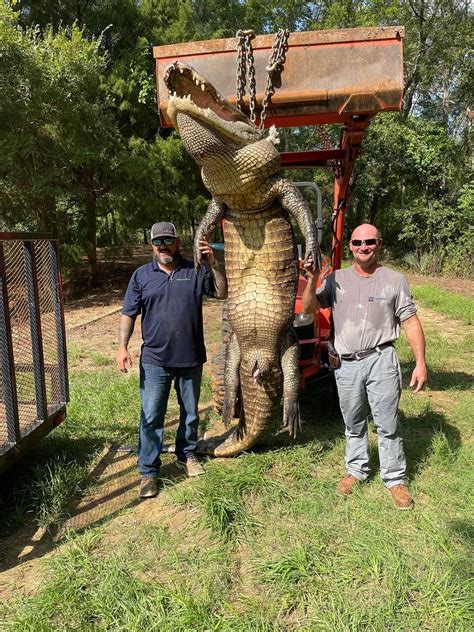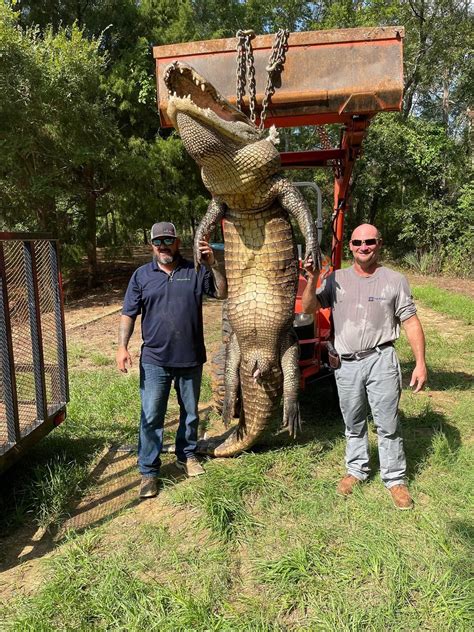
A sizable alligator, measuring approximately nine feet in length, recently caused a stir when it was spotted casually traversing the parking lot of a restaurant in Humble, Texas, providing patrons with an unexpected and memorable wildlife encounter.
Humble, TX – Diners at a Texas restaurant got a side of wildlife with their meals recently when a nine-foot alligator was seen casually strolling through the parking lot. The unexpected visitor, captured in photos and videos, created a buzz on social media and highlighted the increasing interactions between humans and wildlife in suburban areas. The incident, which occurred in broad daylight, serves as a reminder of the diverse ecosystem thriving within the state and the importance of remaining vigilant in areas where alligators are known to inhabit.
According to witnesses, the alligator appeared unfazed by the presence of onlookers as it ambled across the parking lot. Its journey was documented by several individuals who quickly took to social media to share their accounts and images of the reptile. The images and videos circulated rapidly, capturing the attention of local news outlets and wildlife enthusiasts alike.
The Texas Parks and Wildlife Department (TPWD) confirmed the sighting and reiterated safety guidelines for residents living in proximity to alligator habitats. TPWD officials emphasized the importance of maintaining a safe distance from alligators and avoiding any actions that could provoke them.
“Alligators are a natural part of the Texas landscape, and while they generally avoid human contact, it’s crucial to be aware of their presence and take necessary precautions,” stated a spokesperson for TPWD. “Feeding alligators is illegal and dangerous, as it can cause them to lose their natural fear of humans and become more aggressive.”
The incident in Humble underscores the ongoing challenge of balancing urban development with wildlife conservation. As human populations continue to expand into previously undeveloped areas, encounters with wildlife are becoming increasingly common. This trend necessitates a greater emphasis on public education and responsible land management practices to minimize conflicts and ensure the safety of both humans and animals.
Experts suggest that the alligator may have been searching for a new habitat or seeking a mate during breeding season. Alligators are known to travel long distances in search of suitable environments, and their presence in suburban areas is not uncommon, particularly near bodies of water.
“Alligators are opportunistic predators, and they will often venture into new territories in search of food and shelter,” explained Dr. Emily Johnson, a wildlife biologist specializing in alligator behavior. “In this case, the alligator may have simply been passing through the area, or it may have been attracted by the presence of water or potential prey.”
The restaurant, located near a bayou, has become a temporary hotspot for alligator enthusiasts, with some visitors hoping to catch a glimpse of the reptile. However, authorities caution against actively seeking out alligators, as this can disrupt their natural behavior and increase the risk of encounters.
The TPWD advises residents to report any sightings of aggressive or nuisance alligators to local authorities. Nuisance alligators are defined as those that pose a threat to public safety or cause property damage.
The recent alligator sighting in Humble serves as a reminder of the importance of coexisting with wildlife and respecting the natural environment. By following safety guidelines and promoting responsible land management practices, communities can minimize conflicts and ensure the long-term conservation of these iconic reptiles.
The incident prompted a series of reactions from local residents, ranging from amusement to concern. Some individuals expressed excitement at the rare opportunity to witness a large alligator in a suburban setting, while others voiced apprehension about the potential risks posed by the reptile.
“It’s definitely not something you see every day,” commented one resident. “I was surprised to see such a big alligator just walking around like that. It’s a reminder that we share our environment with these creatures, and we need to be respectful of their space.”
However, others expressed concerns about the safety of children and pets in the area. “I’m worried about my kids playing outside,” said another resident. “I don’t want them to accidentally stumble upon an alligator. It’s important to be vigilant and take precautions to protect our families.”
Local authorities have increased patrols in the area to monitor the alligator’s movements and ensure public safety. They are also working to educate residents about alligator safety and dispel common misconceptions about the reptiles.
“Alligators are generally shy and reclusive animals, and they typically avoid human contact,” explained a local law enforcement official. “However, it’s important to remember that they are wild animals, and they can be dangerous if provoked. We urge residents to keep their distance from alligators and report any concerns to us.”
The incident has also sparked a renewed debate about the role of humans in wildlife conservation. Some argue that increased urban development is encroaching on natural habitats, leading to more frequent encounters between humans and wildlife. Others maintain that responsible land management practices can minimize conflicts and ensure the coexistence of humans and animals.
“We need to find a balance between urban development and wildlife conservation,” said a local environmental advocate. “We can’t continue to expand into natural habitats without considering the impact on wildlife. We need to implement sustainable land management practices that protect both human communities and the environment.”
The alligator sighting in Humble is a reminder that wildlife encounters can occur in unexpected places, and it underscores the importance of being aware of our surroundings and taking necessary precautions. By following safety guidelines and promoting responsible land management practices, we can minimize conflicts and ensure the long-term conservation of these magnificent creatures.
The presence of alligators in Texas is a testament to the state’s rich biodiversity. These reptiles have inhabited the region for millions of years, and they play an important role in the ecosystem. Alligators help to control populations of other animals, such as fish and rodents, and they also create habitats for other species.
The American alligator (Alligator mississippiensis) is the only species of alligator found in Texas. They are typically found in freshwater habitats, such as swamps, marshes, rivers, and lakes. Alligators are carnivores, and their diet consists primarily of fish, turtles, snakes, birds, and small mammals.
Alligators are well-adapted to their environment, and they possess a number of unique features that help them to survive. They have powerful jaws and sharp teeth that allow them to capture and consume prey. They also have a strong tail that they use for swimming and balance.
Alligators are ectothermic animals, meaning that they rely on external sources of heat to regulate their body temperature. They often bask in the sun to warm up, and they may also seek shelter in the water to cool down.
Alligators are generally solitary animals, but they may congregate in groups during breeding season. The breeding season for alligators in Texas typically occurs in the spring. During this time, males will compete for the attention of females, and they may engage in elaborate courtship displays.
Female alligators build nests out of vegetation and mud, and they lay between 20 and 50 eggs. The eggs incubate for approximately 65 days, and the female will guard the nest during this time. When the eggs hatch, the baby alligators, known as hatchlings, are about 8 inches long.
Alligators are a protected species in Texas, and it is illegal to hunt or harass them without a permit. The TPWD regulates alligator hunting to ensure that the population remains healthy and sustainable.
The alligator sighting in Humble is a reminder of the importance of protecting these magnificent creatures and their habitats. By following safety guidelines and promoting responsible land management practices, we can ensure that alligators continue to thrive in Texas for generations to come.
The incident has also highlighted the importance of public education about alligators. Many people have misconceptions about these reptiles, and it is important to dispel these myths and provide accurate information about their behavior and ecology.
The TPWD offers a variety of educational resources about alligators, including brochures, videos, and online articles. These resources provide information about alligator safety, habitat, and conservation.
The TPWD also conducts outreach programs to educate communities about alligators. These programs include presentations, workshops, and field trips.
By providing accurate information about alligators, the TPWD hopes to promote a greater understanding and appreciation of these magnificent creatures.
The alligator sighting in Humble is a reminder that we share our environment with a variety of wildlife, and it is important to be respectful of their space. By following safety guidelines and promoting responsible land management practices, we can minimize conflicts and ensure the long-term conservation of these animals.
The incident serves as a case study in human-wildlife interaction, highlighting the challenges and opportunities that arise when human populations and wildlife coexist. It underscores the need for proactive measures to mitigate conflicts and promote harmonious relationships between humans and animals.
The TPWD is committed to working with communities to address these challenges and ensure the long-term sustainability of Texas’s wildlife resources. The agency is actively involved in habitat conservation, population management, and public education.
The TPWD also collaborates with other agencies and organizations to promote wildlife conservation. These partnerships are essential for addressing the complex challenges of managing wildlife in a rapidly changing world.
The alligator sighting in Humble is a reminder that we all have a role to play in wildlife conservation. By making informed decisions and taking responsible actions, we can help to ensure that future generations will have the opportunity to enjoy the wonders of the natural world.
The economic impact of alligators in Texas is also worth noting. Alligator hunting and ecotourism generate significant revenue for the state. Alligator hunting is a popular sport, and it provides income for landowners and hunting guides. Ecotourism, which includes activities such as alligator viewing and photography, also contributes to the state’s economy.
The TPWD manages alligator populations to ensure that hunting and ecotourism are sustainable. The agency sets harvest limits and enforces regulations to prevent overexploitation of the species.
The alligator sighting in Humble is a reminder that alligators are a valuable resource for Texas, both ecologically and economically. By managing alligator populations responsibly, we can ensure that these magnificent creatures continue to thrive in the state for generations to come.
The incident also underscores the importance of responsible pet ownership. Pets can attract alligators to residential areas, and they can also be vulnerable to alligator attacks.
The TPWD recommends that pet owners keep their pets on a leash when walking them in areas where alligators are known to inhabit. They also advise against allowing pets to swim in waterways where alligators may be present.
By taking these precautions, pet owners can help to protect their pets from alligators and prevent conflicts between humans and wildlife.
The alligator sighting in Humble is a reminder that we all have a responsibility to protect wildlife and their habitats. By making informed decisions and taking responsible actions, we can help to ensure that future generations will have the opportunity to enjoy the wonders of the natural world.
FAQ Section:
Frequently Asked Questions (FAQs) About Alligator Sightings in Texas
-
What should I do if I encounter an alligator?
If you encounter an alligator, it is crucial to maintain a safe distance. According to the Texas Parks and Wildlife Department (TPWD), you should “observe the alligator from a distance” and avoid approaching or feeding it. “Never feed alligators,” as this can cause them to lose their natural fear of humans and become more aggressive. If the alligator poses an immediate threat or is displaying aggressive behavior, contact your local authorities or the TPWD. Remember, alligators are wild animals and should be treated with caution and respect.
-
Is it common to see alligators in suburban areas of Texas?
While alligators are primarily found in freshwater habitats such as swamps, marshes, rivers, and lakes, it is not uncommon to see them in suburban areas of Texas, especially those near bodies of water. As human populations expand and encroach on natural habitats, encounters between humans and wildlife, including alligators, become more frequent. This is why it’s important to be aware of your surroundings and take necessary precautions when living in or visiting areas known to be alligator habitats. The alligator in Humble serves as an example of their presence.
-
What makes an alligator a “nuisance alligator,” and what happens to them?
A “nuisance alligator” is defined by the TPWD as an alligator that poses a threat to public safety or causes property damage. This could include alligators that repeatedly approach humans, attack pets, or damage property. If an alligator is deemed a nuisance, the TPWD may authorize its removal. Removal methods vary, but often involve relocating the alligator to a more suitable habitat away from human populations. In some cases, if relocation is not feasible or the alligator poses a significant threat, it may be euthanized. Reporting such instances to local authorities or the TPWD is crucial for proper management.
-
What are the laws regarding alligators in Texas, and is it legal to hunt them?
Alligators are a protected species in Texas, and it is illegal to hunt or harass them without a permit. However, the TPWD does regulate alligator hunting through a permit system to ensure that the population remains healthy and sustainable. Alligator hunting is typically allowed during specific seasons, and hunters must adhere to strict regulations regarding the size and number of alligators that can be harvested. It is essential to consult the TPWD’s regulations and obtain the necessary permits before engaging in any alligator hunting activities.
-
How can I help protect alligators and their habitats in Texas?
Protecting alligators and their habitats involves several key actions. First, avoid feeding alligators, as this can alter their natural behavior and create dangerous situations. Second, support habitat conservation efforts by advocating for responsible land management practices and protecting wetlands and other vital alligator habitats. Third, educate yourself and others about alligators and their role in the ecosystem. Finally, report any illegal activities, such as poaching or habitat destruction, to the authorities. By taking these steps, you can contribute to the long-term conservation of alligators and their natural environment.









